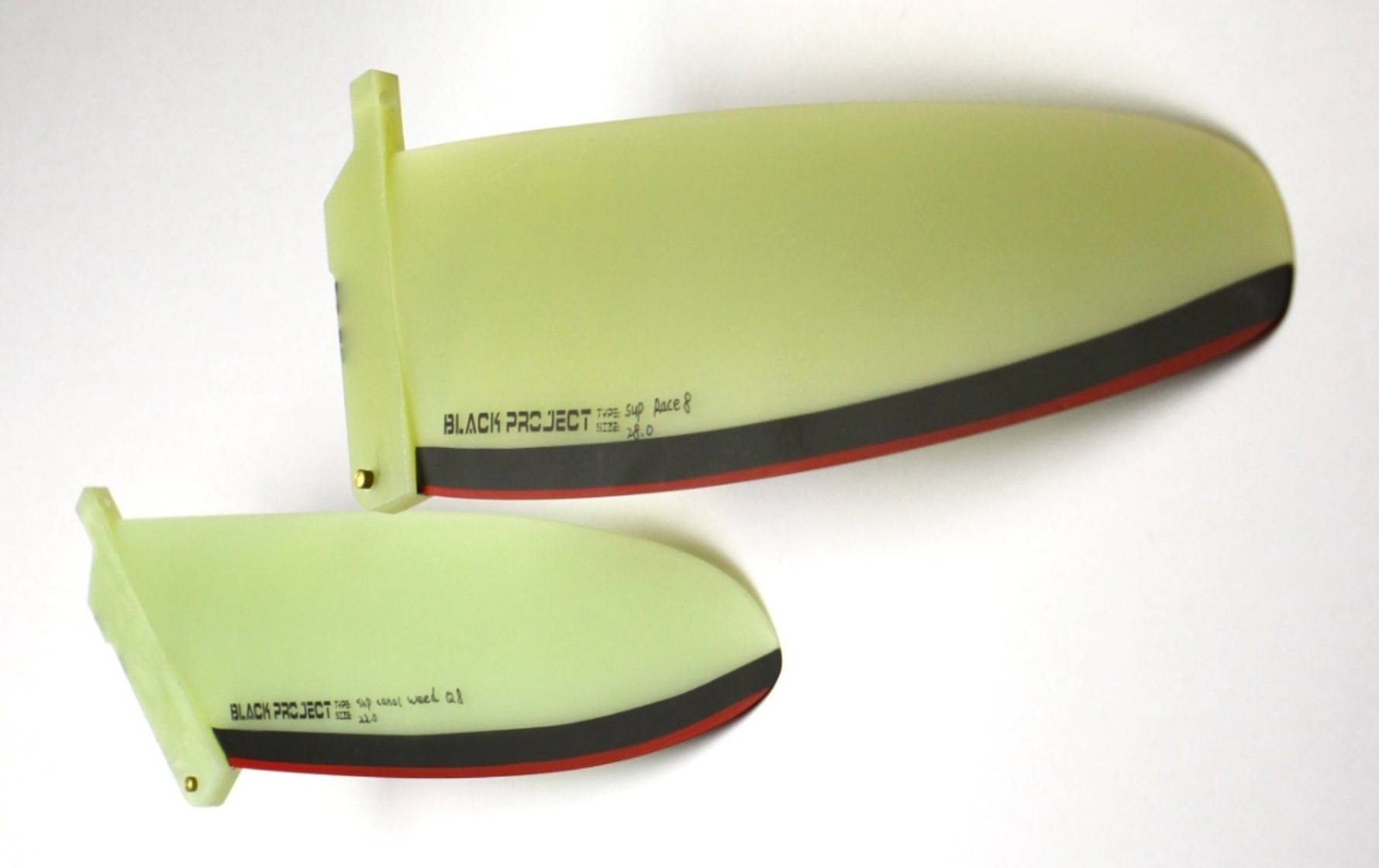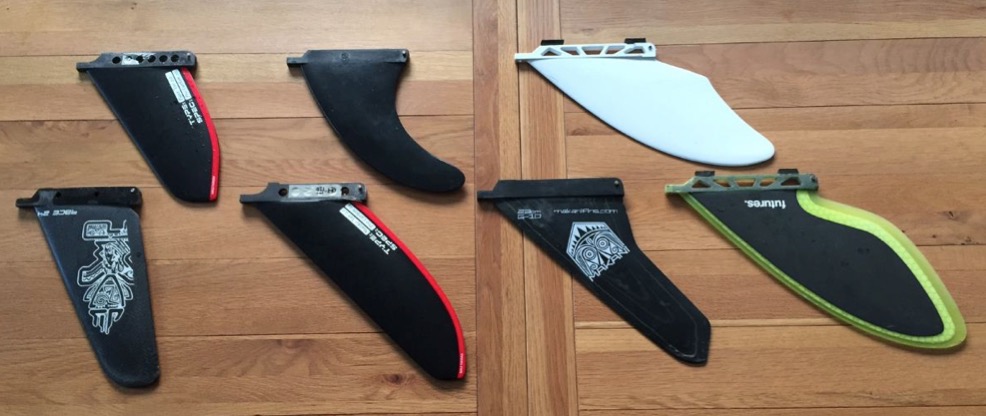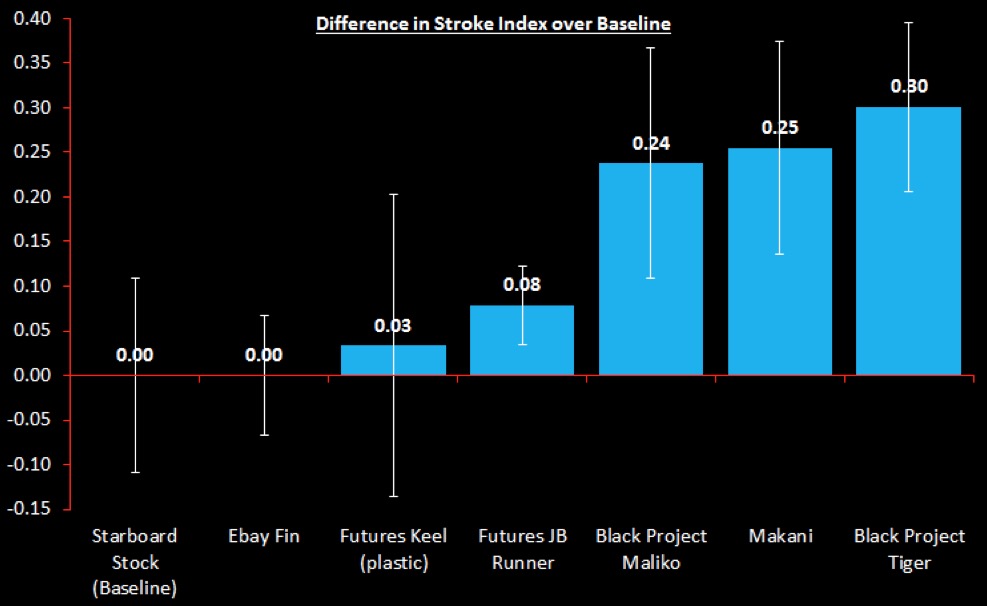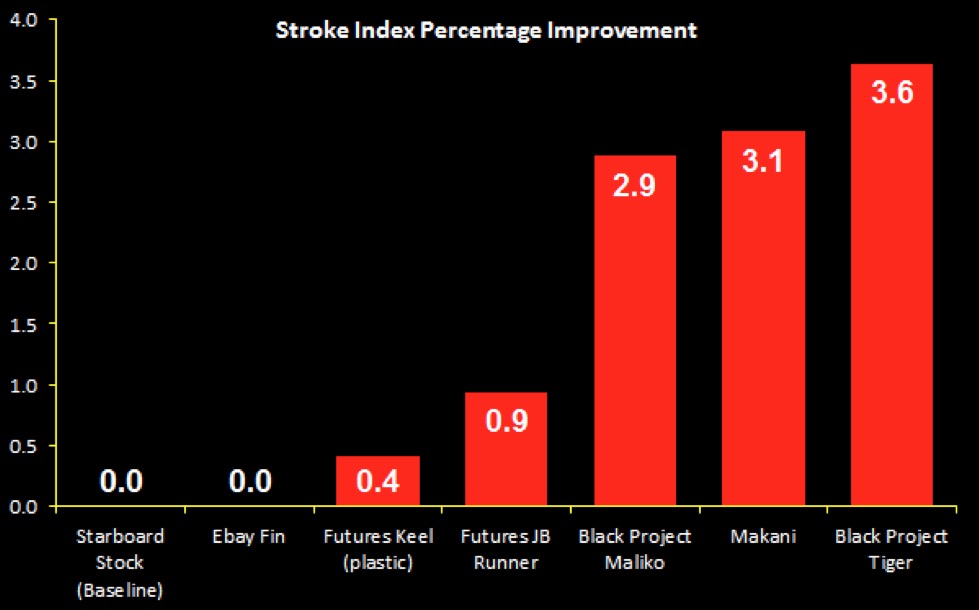
There are many different types of SUP race fins designed for different uses (long straight courses or multiple buoy courses) but they are all designed with something in common… to be fast! Most new boards come with a fin, but does that necessarily mean it’s the best fin for you?
Regular SUPboarder contributer and tester Dr Bryce Dyer gets technical once again, but this time with fins. Do they really make a difference? If so what impact do they have on our paddling? And, should we be thinking about our fin choice as much as our board choice?
Fin Testing 101: What’s in a fin ?
A few months back I wanted to see if it were possible to test SUP equipment so that paddlers could rely on something other than guesswork when seeing how they could get faster. I successfully started out evaluating boards first and then I looked at increasingly smaller changes in equipment to see if I could still pick up any differences when field testing. As a result, in this last part of my SUP equipment testing trilogy, I have attempted to test the smallest piece of equipment change you can make of all – the fin. After all, a fin is considerably cheaper than buying a new board. I’ve now had a go myself by testing 7 well known SUP race fins with everything from the very cheap to the expensive and from the very small to the gigantic. The aim though isn’t to say what fin is best per se’ but instead to determine whether I could see a reliable difference between them and to determine their effectiveness.
First things first, let me disclose any potential conflicts of interest I could have. The Black Project fins were kindly donated by Black Project themselves. Likewise the Makani fin was donated by Ed Sinofsky Ph.D. All the other fins were purchased by myself. Whilst I do have some sponsors this year, none of these are fin related. I performed the tests using a SUP Speedcoach GPS device which was kindly donated to me by Nielsen-Kellerman. I also used a Garmin 910XT as a back-up (and to act as a form of data comparison).
The Tested Fins: Black Project Maliko, Black Project Tiger, Futures Plastic Keel, Futures JB Runner, Makani, Starboard stock fin and (an intentionally) rather cheap basic surfing fin from eBay. The test board was a 26.5 width, 14ft long allwater carbon race board
The limitations of these tests: Fin choice will be dictated primarily by your boards design and your current level of ability. For example, if your boards’ underside varies in shape, it’s entirely possible that a fin would perform slightly differently between them. Likewise, if you are new to the sport, you may find some of the smaller fins are too small to remain stable and this would affect your results. Ultimately, the best fin to choose is the best one paired to the board and its paddler.
The Tests:
Taking what I’ve learnt from when testing boards and paddles, I performed two separate tests of the fins. My aim was to look at fin performance specifically from a flatwater racing point of view. Whilst aspects such as buoy rounding is important, that was outside the intended scope of my own racing interests and therefore of these tests. I wanted to evaluate straight-line speed only.
The environment used for the tests was a heavily sheltered inland reservoir with no currents. The tests were performed early in the morning when no wind was evident at all. The water was glassy and smooth in nature and no other craft or influencing factors were on the water as I tested. Both my paddle and board were marked with tape so I could get a consistent stance and paddling position with both my feet and hands. Test 1 was performed on two occasions (with the fin samples split in half but with two fins being used as controls on both occasions). Test 2 saw all the fins tested together. To give you an idea of the time required, test 1 required two 2 hour sessions and test 2 took another couple of hours. That’s 6 hours total testing time (and then the time on top of that for the analysis).
Test 1: 300m Race Pace Testing at 9kph.
It’s important that you test equipment at the pace that you would typically race at as this will see the board subjected to the conditions it would face in your own races. 9kph is my typical long distance race pace on water like this. I paddled at this speed over the same 300m straight line – changing sides with the paddle to hold the course. At the end of each run, I would paddle at a very light pace back to the start and then begin again. I completed 6-8 runs with each fin and these were randomised in test order. There is always a chance of the placebo effect affecting the results (and there is no way to blind test fins) so it’s important to do as many runs as you have time for and then look at how varied the data is.
The key metric that was then calculated afterwards to judge the results was the ‘Stroke Index’ (SI). This metric was based on the premise that it had been found that neither stroke length nor stroke-based accelerations correlated as a key performance indicator for canoe or kayak paddling. The problem with distance per stroke alone is that it will vary based on paddling speed and that the stroke length is typically longer at slower paddling speeds and shortens with increasingly faster ones. To address this, published research has used the SI in sports like swimming and rowing to provide a basis to compare athletes or crews against each other. To calculate your SI, you merely multiply your average speed in metres per second for a test run by its average distance per stroke in metres. If you’re wondering how to find out your average distance per stroke easily, just divide the length of your test run by the number of strokes you took to perform it. You’ll likely find that your distance per stroke is typically somewhere in the 3-4 metre range and the larger the SI score, the more effective and efficient your paddling is. I find it’s also essential to record the data variability and margin of error for all tests.
Test 2: Deceleration tests
These tests are performed by accelerating the board quickly until 10 kph is reached. Once this speed is achieved, the paddle is removed from the water and placed on the deck, upright in a vertical position, in line with my feet. The board will then slowly coast to a stop. In theory, the greater the level of hydrodynamic drag, the faster you’ll slow down. I’d used this test successfully before when comparing boards and obtained both consistent and reliable results. The target speed range was used as it is representative of my own racing and is easily repeatable many times. The advantage of this test is that it minimises any placebo effect as you’re not paddling at all when you glide so you’re basically putting Sir Isaac Newton in the driving seat instead.
In your raw data, if you look at the peak speed you obtain, deduct off your final speed and then divide the result by the time taken to slow down from one to the other, that’s your deceleration. The greater that is, the greater the hydrodynamic drag is being created by the change in the fin. I personally convert kph to metres per second for this (and you can do this by dividing the kph speed by 3.6). I did 6-8 runs of every fin and they were randomised in their running order. I also tested the Starboard fin at the beginning (and again at the end) to act as a baseline and to ensure the test conditions did not change.
Results:
Test 1:
Here is the data showing the improvement in SI when compared to the Starboard fin I used as a baseline. The bigger the difference to the baseline, the better the fin.
In this, you can see that the eBay fin was no worse than the baseline fin. The other fins all started to show some measure of improvement. However, it’s important to also note the error bars (the white lines showing a + or – of the data I got) for each fin. If you look carefully, you’ll see that the top 3 fins overlap each other meaning that the Black Project Tiger performed the best but did not do so significantly over the Black Project Maliko and the Makani. [note: for the statisticians out there, I did test the significance and whilst these three fins as a group are significant and superior to all the other fins tested, these three are not from each other]. In real terms though, the next graph shows the percentage improvement in stroke index over the baseline.
So, you’re getting a stroke index improvement with the best fins by roughly a whopping 3-4%. That is arguably a huge increase in paddling efficiency – just by switching your fin out. Plus, since the speed was the intended control of the test, it’s likely that this gain is mainly attributed to a gain in the stroke length. If that’s true, that 3% would be a gain in stroke length of roughly 10cm per second (or about ~360 metres in distance per hour). Bear in mind that’s a rough approximation but that is the same margin I’ve tested before between two race boards of the same length and width.
By the way, the coefficient of variation (i.e. the variability of the data) was just 1% for each fin test. That’s as good (if not better) than you’ll see in many sports science lab tests. Bearing in mind this is from the more chaotic world of field testing, I’m very confident on the quality of the data I got.
Test 2:
Here is a graph showing the deceleration data from the Speedcoach of the 7 fins.
To keep things simple, I’ve left the vertical scale off. However, as you can see, the reality is that I couldn’t detect a clear difference in drag between any of the fins. When you look at the white error bars, there is such an overlap between all 7 fins, not one of them is statistically significant from each other. I got the same story when I looked at my back-up Garmin data. So, does this mean that when it comes to hydrodynamic drag alone that fin choice doesn’t matter ? Not necessarily. It may just mean that the differences are beyond the ability of this test or the equipment I use to measure it. It’s also worth noting that the variability of the data in these trials was ok but was much larger at around 6%…. which is still ok but odd bearing in mind the lack of need to do anything other than just stand still.
So then…..
The equipment you use to do these tests is important. I found Garmin’s ok for test 1 (provided you have a cadence sensor) but the low sampling rate will increase the chances of poorer data. It’s worth using the best and highest sampling GPS unit you can find that will allow you to record your stroke rate. My Speedcoach was fine on test 1 but even that struggled with test 2. I’d have to say if you are testing between boards, fine – but if it’s with something as small as a fin, you’ll likely have to stick to test 1 alone.
So let’s answer the questions my tests set out to look at. Can field testing reliably pick up the differences between fins? The answer is yes. As a result, it’s possibly worth thinking about the fin you are currently using. As the cheap Bay purchase showed, don’t skimp and assume a fin is just a fin and save some pennies. It’s a false economy when it comes to performance.
The second question is: ‘is it worth upgrading ?’ The answer is yes….. if you choose wisely. However, when you look at the best fins in this study, the margin between them is now also increasingly marginal. Attempting to upgrade an already decent fin may well be a case of diminishing returns. It might then be worth judging them based on how they affect your stability. The big finding for me here is that good fin choice is free efficiency and therefore free straight-line speed. That’s a lot cheaper than blaming (and then replacing) your board.
The final question is: ‘what fin would I select ?’ The answer is any of the top 3 fins from test 1. However, I’d want to spend more time with the Tiger as I feel it had a tendency to not track as well as the other two meaning I had to swap sides more often (and that the swapping of sides more frequently could skew the data both positively or negatively). I may need to modify my stroke to get the best out of it. Swapping sides wastes energy in a distance race so I’d be inclined (in the meantime) to select either the Black Project Maliko or the Makani and I’ll likely retest all 3 to match the best one to any new race board I get in the future.
The key thing here is that the actual difference in drag I picked up here in test 2 here was so minimal between the fins, it’s not worth worrying about as a priority. Fundamentally, the impact of a fin on your stroke efficiency is more important than the raw hydrodynamic drag caused by it alone. Either way, it’s certainly worth now looking at your board in a different way – i.e. rather than just going for a narrower board, you could play with the fin instead. Fin and board have a symbiotic relationship with each other. For example, (whilst I didn’t see it here), it might be worth trimming inches off your fin rather than inches off your board width to get the best efficiency and speed for yourself. This is particularly important if you’re a larger paddler who needs board volume so can’t go to a narrower option but is still looking for a bit more speed. Ultimately, fin choice is relevant, has an impact and is well worth testing out ahead of next season.
Words : Dr Bryce Dyer
Dr Bryce Dyer is Head of Research in the Dpt of Design & Engineering at Bournemouth University and raced in the N1SCO class for Naish UK this season.
Thankyou Bryce for sharing some more fascinating research. Fins may be small and seen by many as just an accessory, but as you’ve clearly shown, they have a big impact on our paddling performance and therefore fin choice as well as board choice is an important deciding factor especially on race day!
To read more of Bryce’s top features on SUPboarder click here.




Would have been interesting to see how a propper race fin like the FCS II Danny Ching or K4 SUP Race Fin stacked up 😉
Great to see a real scientific approach to all aspects!
Yep, I contacted both the companies mentioned but only some responded. Still, you can find a reservoir to check your own fins and it should be a test anyone can do with a bit of practise.
You should have contacted SUPNorth Bryce, we could have sorted you out I’m sure 😉